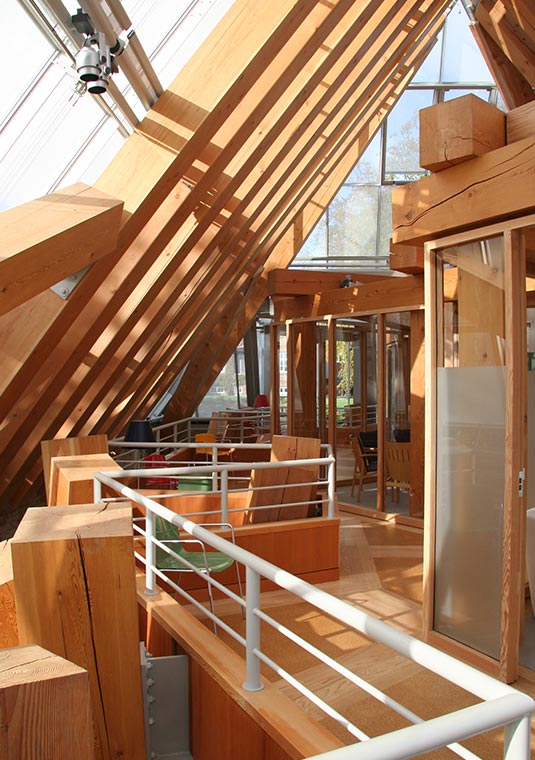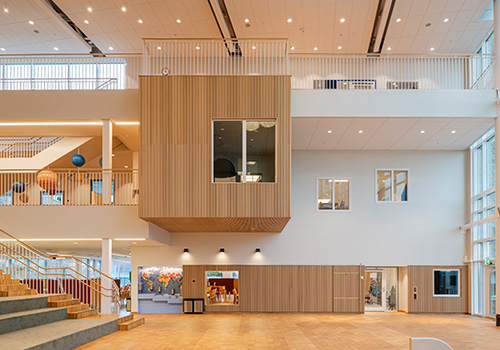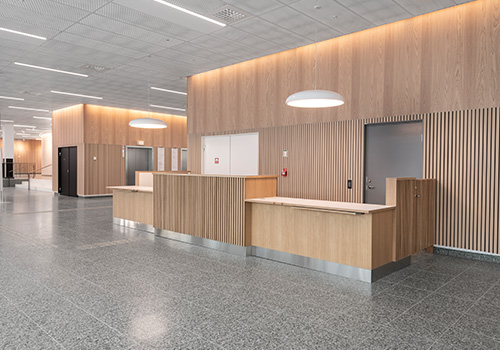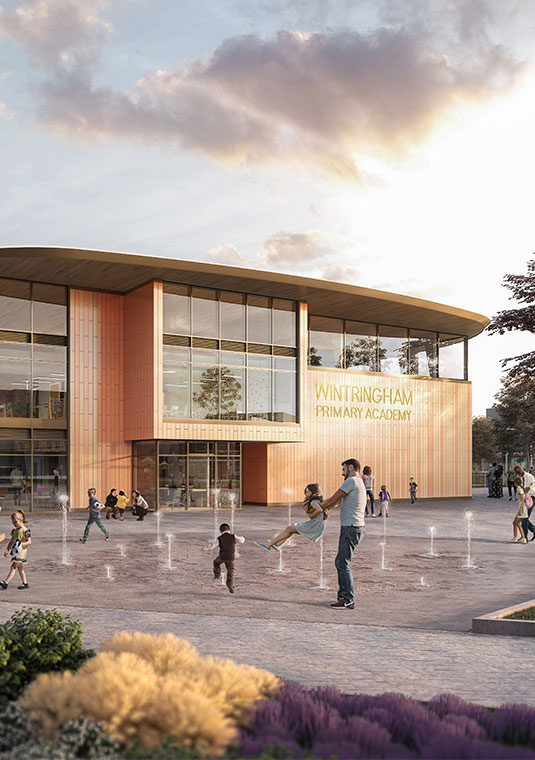Our latest news and views English
Underpinned by our Scandinavian design heritage, we bring you regular stories about architecture and interiors, exploring natural materials, acoustics, and the creation of safe and harmonious environments.
We are sensitive beings, susceptible to stress in all aspects of life, and our built environment greatly influences how we process potentially stressful situations. Frank Lloyd Wright once said “Study nature, love nature, stay close to nature. It will never fail you.” Studies show that nature is not only the ultimate blueprint of building design, but that staying close to nature by spending time in buildings with wood interiors, can calm us down and help us to regulate our emotions. Nature won’t let you down in your time of need.

It’s a feeling we all can recognise, even the subtlest hint of it, but what exactly is ‘stress’?
Stress is the involuntary, ‘fight or flight’ physiological reaction triggered by hormones. It’s the ultimate survival mechanism activated when we’re confronted by something frightening or life-threatening. For our ancestors, and animals in the wild, this attack-or-run-response was often the difference between life and death. Today, this stress response is more likely activated by everyday irritants, like a traffic jam or a slow internet connection.
When we perceive a threat, either from the outside, or an internalised anxiety, the production of adrenaline makes our heart pump faster, our lungs speed up breathing, and in the stomach, digestion is slowed down. In the short-term, this hard-wired response can be advantageous – it helps us get stuff done – but prolonged periods of stress has damaging effects on our mind and body.
Some of the earliest stress studies coincided with the first World War, with the analysis of the blood of soldiers that were suffering with what we now refer to PTSD. The understanding of how stress is intertwined with the experience of more everyday physical environments is much more recent.
‘Neuroarchitecture’ is the evolving study of how our brains respond to environments. Our mood and behaviour can be directly altered by our environment, both in the short and long term. Whilst only in its infancy, studying the intersection between human psychology and design opens up new possibilities for creating buildings that can maximise wellbeing and reduce stress.
She also points out that the physicality of a workplace brings with it a feeling of context. “When a group of people reside in the same pWhen we consider physical environments related to stress, most of us probably think of workplaces.
This isn’t surprising – research commissioned by the UK-based mental health charity, Mind, found that work is the most stress inducing aspect of our lives. In the UK, a staggering 17.9 million working days were lost due to work-related stress, depression or anxiety in 2019-20, accounting for 51% of all work-related ill health cases and 55% of all lost working days due to ill health.
But it’s not just office environments that can benefit from more insightful, wellbeing-enhancing design. Considering that we spend over 90% of our lives indoors, every building has the potential to influence how we feel (for better or worse).


Nature’s ability to enhance our wellbeing was brilliantly captured in a 1984 study by Dr Roger Ulrich. Ulrich measured the restorative effect of natural views for patients following surgery in a Pennsylvania hospital. Postoperative anxiety is usually high, and access to outdoor and natural environments very limited.
Ulrich compared the recovery periods of patients and the view they had through their window: either a brick wall, or treetops. Patients with a tree view had shorter postoperative stays and less negative responses to nurse evaluations. The study was one of the first to suggest the therapeutic benefits of nature.
More recent studies have shown that using natural materials in classrooms, particularly wood, can reduce stress and heart rates in students. Wood’s calming affect helps children focus and relax, encouraging participation in classroom activities. By bringing the outside indoors, wooden classrooms provide a biophilic experience for students – tapping into humankind’s innate biological connection with nature.
Utilising engineered timber construction, Wintringham Primary Academy, completed in 2020 by dRMM, is an excellent example of integrating nature into the architecture of educational settings. “The school design draws inspiration from ‘forest school’ principles and the concept of naturalness,” comments Philip Marsh, co-founding Director of dRMM. “Dual aspect classrooms bring natural light, ventilation and nature to the classrooms, and connects pupils externally to a wider experience of age-related landscape, outdoor classrooms, play areas, orchards and allotments.”
The positive psychological properties of wood have also been recorded in care homes, with an increase of interaction between residents and greater awareness of their surroundings, reported with the introduction of wooden trays in dining rooms. A report by Lund University from 2013 states that wood can elicit an emotional response from the elderly too.
A project by Wood2New from 2017 explored human perception and the psychological aspects of interior wood use. The study found that wood’s air purifying, moisture balance and hygrothermal capacity, along with its acoustic properties, are strongly linked to users’ wellbeing. Interestingly, the perception of wood as an ecological material, compared to plastics and metals, also contributed to the sense of wellbeing wood interiors provide.
In 1956, the ‘father of stress’ and author of The Stress of Life, Hungarian-Canadian scientist, Hans Seyle, wrote: “Stress is essentially reflected by the rate of the wear and tear caused by life.” Life – the majority of which we spend indoors – is and always will be, filled with stressful situations. When we design indoor environments, mitigating the stress of its users should be a priority, and when it comes to materials, wood is perhaps the best tonic to life’s wear and tear.
